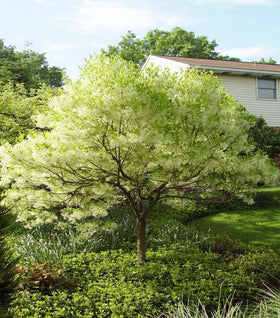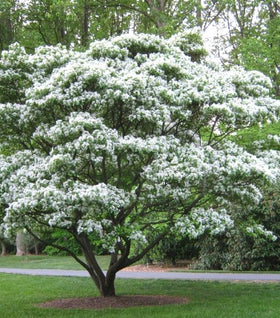Fringe Trees for Sale Online
Fringe trees are small to medium-sized flowering trees that grow up to 20 to 25 feet tall. Typically they are seen in the home landscape between 15 to 20 feet. In the late spring, fragrant, white flower clusters are seen hanging from the tree, which turns to dark blue hanging berries in the late summer. Fringe trees are underused small trees in the US, and once you see the beautiful flowers for yourself, you'll know immediately that this tree should be in all landscapes, big or small.
American Fringe Trees
The American White Fringe Tree or Chionanthus virginicus is native to portions of the southern states up the eastern seaboard to south-eastern Pennsylvania. They generally grow to heights of 20 to 25 feet in the landscape and up to 15 feet wide. They typically flower in the Spring and into early summer, producing white flowers with a fine texture and a faint fragrance.
American Fringe Trees will begin flowering before the green leaves appear and will begin to produce leaves while still in flower after flowering dark blue fruits appear from August to September. As well as adding some ornamental interest to the fall landscape, the fruit attracts birds, which will lend an added level of interest to the landscape.
The clear yellow fall color completes the show and allows this tree to remain beautiful throughout the year. If you are looking to plant a native tree, the American Fringe Tree is very tolerant of Clay soils and air pollution, making this a good choice for urban gardens. The fibrous root system allows this native plant to be planted close to foundations and sidewalks with little concern for damage from the root ball.
Chinese Fringe Trees
The Chinese Fringe Tree or Chionanthus retusus also produces pure white, fragrant flowers that emerge just as dogwood flowers are starting to fade. The snowy white flowers cover the tree for 3 to 4 weeks.
Chinese fringe trees flower after the leaves emerge in the spring, unlike our native fringe tree. The leaves of this tree also turn a gorgeous yellow color in the fall. The Chinese variety of fringe trees stays smaller than its American counterpart and is often best suited for smaller gardens or an accent tree in smaller yards.
Chinese Fringe tree maintains a rounded shape naturally and requires no pruning. Typically grown as a multi-stemmed tree, its branching structure adds architectural interest to any landscape. Chinese Fringe trees grow best when planted in full-sun locations in average to well-drained soil. Chinese Fringe trees are not quite as hardy as American Fringe trees, but the difference is only one growing zone.
Planting Fringe Trees
After you've chosen the variety of Fringe trees best suited for your landscape, there are a few easy steps to follow for planting your tree. Fringe trees can be planted at any time of the year as long as the soil can be worked. Fringe trees do well in full sun but will tolerate light shade, especially in the warmer areas of their range.
Step 1: Water the Potted Fringe Tree thoroughly while it is in the pot. Water until you see the water running out of the bottom of the pot.
Step 2: Dig a hole twice as wide as the pot the tree is growing in. The depth of the hole should be as deep as the root ball, but not deeper. After the tree is planted, you should still be able to see the original nursery soil. Planting the Fringe Tree too deep is the leading cause of poor growth and death of newly planted trees.
Step 3: If your existing soil is of poor quality, you should amend the soil with local compost or peat moss at a 50/50 rate. Compost is typically available at your local garden center and can easily be purchased in bags or bulk. This is also the time to mix in an organic starter fertilizer such as Bio-tone by Espoma.
Step 4: Gently Place the Fringe Tree in the prepared hole, careful not to overly disturb the roots. It is ok to fluff the roots if the tree is rootbound. This will cause the tree roots to begin to grow out and down rather than circle the root ball.
Step 5: Begin back-filling with the amended soil in 3 to 4-inch layers being careful to tamp the soil between layers. This will remove air pockets and voids created by larger chunks of soil. Be cautious not to damage the existing roots of the tree during this process.
Step 6: Use the leftover soil to create a 3 to 4-inch rim around the planting hole's edges. This will allow water to pool around the newly planted tree and slowly seep into the root zone. Proper watering is essential to the survival of the tree.
We also recommended mulching the newly planted Fringe Tree. This helps prevent the sun from drying out the soil and damaging the truck from mowing equipment such as string trimmers.
Watering Fringe Trees
After you have planted your Fringe tree, it should be watered about every 2 to 3 days for the first 4 weeks. After that, begin to cut back on the watering frequency but not the amount of water. When watering, be sure to soak the entire root system. Remember that the root system is usually 18 inches deep on a newly planted tree, and water should soak all the way through the bottom.
Two of the easiest ways to water newly planted trees is to lay the end of the hose at the base of the tree inside the rim and allow it to trickle at the base for 30 to 40 minutes or until you see the water begin to pool.
The second way and our favorite way is to use a Treegator Watering Bag. Install the bag at the base of the tree and fill it with water. Water is allowed to slowly drain from the bag providing the perfect amount of water to the root zone.
Using Fringe Trees in the Landscape
Because Chinese Fringe trees begin flowering as American Fringe trees are done flowering, you could plant both types in your landscape and enjoy the fringe Flowers for over two months every year.
Fringe Tree flowers stand out when planted in front of red brick homes or in front of evergreen trees such as Thuja Green Giant or Arborvitae Emerald Green. The dark backdrop of these evergreen trees makes the white flowers stand out even from a distance.
Are Fringe Trees Deer Resistant?
The Chinese Fringe Tree (Chionanthus retusus) is noted to be very deer resistant and is a great choice for areas of high deer pressure. The American Fringe tree is also deer resistant but in extremely cold and long winters deer will occasionally browse the lower branches of this tree.


